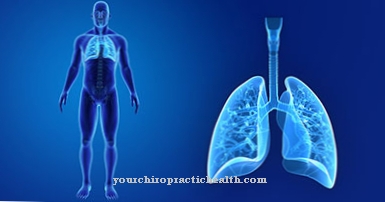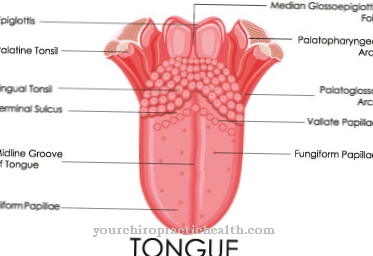The Baló disease is a neurological disorder also known as concentric sclerosis and is the acute variant of multiple sclerosis. Damage in the white matter, which forms a clearly visible ring pattern as a result of demarking, is the main characteristic of Baló's disease. The treatment is usually medicated.
What is Baló disease?

© Robert Kneschke - stock.adobe.com
The spiral de-marrowing of the white matter in the central nervous system (CNS) is the main feature of the Baló disease. The white matter is the myelinated (and thus electrically isolated) fibers of the nerve cells. In 1928 the Hungarian József Baló described the disease for the first time in deceased patients.
With the help of magnetic resonance imaging (MRI), medical professionals can now visualize the characteristic clinical pattern in the cerebrum: The neurodegenerative disease leaves concentric circles in the white matter that resemble the annual rings of a tree or a cut onion.
They arise from the fact that the demyelinating does not attack the myelin cells evenly, but causes alternating stronger and weaker shrinkage. Baró's disease is a variant of multiple sclerosis, which is also characterized by demyelinating of the white matter and often progresses in phases. As synonyms for the disease apply concentric sclerosis Baló, Encephalitis periaxilis concentrica such as Baló's disease.
causes
The specific causes of concentric sclerosis have not yet been adequately researched; they are due to more than one influence and are therefore multifactorial. Baló's disease is the acute variant of multiple sclerosis and may therefore be due to similar risk factors. These factors include genetic predisposition and environmental factors.
In the specialist literature, scientists discuss factors such as dietary influences such as vitamin D deficiency and infections with the Epstein-Barr virus. According to the current state of knowledge, demyelinating is caused by inflammation in the CNS, which in turn is due to an autoimmune reaction. In multiple sclerosis, the chronic form, several foci of inflammation appear.
Researchers explain the concentric circles as a substance that arises outside of the brain and migrates through the blood-brain barrier into the tissue by spreading rhythmically by means of diffusion. This type of diffusion is due to the properties of the tissue and is not specific for this substance, which damages the myelin as it spreads and thus leaves concentric circles in the tissue. Depending on which areas of the nervous system are damaged, the disease can manifest itself in different symptoms.
Symptoms, ailments & signs
The externally visible and noticeable symptoms of Baló's disease can vary greatly depending on the patient. Depression, ataxia, impaired cognitive performance, movement disorders, spasticity, paralysis and pain without an identifiable physical cause are symptoms that can occur in multiple and concentric sclerosis.
Sensitivity disorders in which the physical sensation of certain stimuli are restricted or fail are also conceivable. Medicine differentiates between four basic types of sensory disorders, each of which can manifest itself in all sensory qualities: reduced sensitivity (hypaesthesia), increased sensitivity (hyperesthesia), misperception of stimuli (dysesthesia; for example pain from light touch) and perception of stimuli that not actually present (paraesthesia; for example tingling in the fingers).
These symptoms can occur in a variety of neurological conditions and include sensitivity to temperature, touch, movement, position, vibration, force, and pain.
Diagnosis & course of disease
An imaging test is required to make the diagnosis; Because of its high spatial resolution, magnetic resonance tomography (MRT) is particularly suitable. Baló's disease is confirmed when the typical concentric pattern in the white matter of the cerebrum is visible on the MRI. In addition, the MRI image shows demyelinating symptoms in almost half of the patients, which suggests multiple sclerosis.
Young adults are particularly well represented among those affected. Doctors cannot yet say with certainty which course is actually typical for Baló's disease: early detection was not possible for a long time, until 2004, many findings about the clinical picture were based on examinations that took place after the death of the affected patient. Reliable predictions are also difficult to make on an individual level. However, Baló's disease is likely to have a single, severe phase.
Complications
In most cases, this disease leads to severe paralysis, which can appear all over the body.As a rule, paralysis in any case leads to severe restrictions on movement and impaired sensitivity, which leads to a considerable reduction in the quality of life. In some cases, the person concerned is dependent on a wheelchair or on the help of other people in everyday life. Spasticity can also occur.
It is not uncommon for mental and motor development disorders to occur in the course of development. This can lead to teasing and bullying, especially among children. Also, stimuli can usually not be properly perceived and those affected are very sensitive to temperatures. It is not uncommon for severe pain to occur. Parents can also suffer from mental illness or depression as a result of the symptoms.
Treatment of this disease is carried out with the help of drugs. There are no further complications. However, not all complaints can be restricted. This may lead to a reduced life expectancy. The affected person is dependent on various therapies.
When should you go to the doctor?
If movement disorders, paralysis, and other signs of concentric sclerosis Baló are noticed, a doctor should be consulted. The condition must be treated before serious complications develop. If health problems have already arisen, a doctor should be called in immediately. The same applies if psychological complaints, such as depression or changes in personality, are added to the physical symptoms. If severe paralysis develops, medical advice is also required.
Parents who notice mental and motor development disorders in their child are best advised to consult the pediatrician. This can diagnose Baló's disease and, if necessary, initiate treatment directly. This is necessary at the latest when the child complains of pain. Since the illness can represent a great psychological burden for the child and parents, a therapist must be called in to accompany the medical treatment. Other contacts are internists and orthopedists. A nutritionist can work out an individual diet in consultation with the parents and thereby alleviate the symptoms.
Treatment & Therapy
To treat Baló's disease, doctors often use glucocorticoids in their practice, but these do not always improve the situation. The steroid hormone also occurs naturally in the human body; the adrenal cortex produces it to break down fats and proteins and to synthesize carbohydrates. In high doses, such as those found in drugs, they inhibit the formation of proteins.
These also include the antibodies of the immune system, which falsely trigger an inflammatory reaction in Baló's disease and multiple sclerosis. Mitoxantrone can also be used as an active ingredient, which is also used in multiple sclerosis; so far, however, there are only individual reports of its effectiveness in concentric sclerosis.
The same also applies to other forms of treatment such as exchanging the blood plasma (plasmapheresis). The attending physician must assess the possibilities and risks of various options individually in each case.
You can find your medication here
➔ Medicines for paresthesia and circulatory disordersOutlook & forecast
Concentric sclerosis Baló is one of the variants of multiple sclerosis, a so-called border form. It affects the central nervous system and, unlike MS, usually does not occur in episodes. In concentric sclerosis Baló, typical lesions that are concentrically arranged form in the demyelinated tissue.
The prognosis of Baló concentric sclerosis is slightly better than that of multiple sclerosis. In some cases there is even a spontaneous remission. In others, an asymptomatic case can take an individual course. In many monophasic courses, the symptoms of acute inflammatory demyelinating disease can be improved.
The disease of the CNS, also known as encephalitis periaxialis concentrica, occurs primarily in young adults. Symptoms depend on which region of the brain is affected. While this disease used to be fatal and could only be diagnosed post mortem, the prospects are better today. Treatment can be initiated by gluco-corticosteroids, immunosuppressive drugs, or plasmapheresis.
If there are lesions in Concentric Sclerosis Baló as in MS, the course of the disease can also be similar and relapsing. This is the case for around a third to half of those affected. In this case, MS drugs are also administered for prophylaxis and relapse prevention. In the case of a monophasic course of the disease, the prognosis is generally better.
prevention
Since the causes of Baló's disease are still largely unknown and the development is based on the interaction of many complex factors, targeted and reliable prevention is not possible.
Aftercare
In most cases of Baló sclerosis, the patient has only a few direct follow-up measures available. A diagnosis of the disease with subsequent treatment must take place very early on so that there are no further complications. If the disease is not treated properly by a doctor, there are usually significant restrictions in movement as it progresses.
These can have a very negative effect on the quality of life of the person affected. Patients with this disease are mostly dependent on the intake of various drugs. You should always pay attention to the correct dosage and continue to take it regularly in order to permanently alleviate the symptoms.
Many patients are dependent on the support and help of other people in their everyday life, whereby the help and care of their own family can have a very positive effect on the further course of this disease. In this context, intensive and loving discussions with the person affected are very important so that depression and other psychological upsets can be prevented. Whether Baló sclerosis will lead to a reduced life expectancy for those affected cannot be universally predicted.
You can do that yourself
Patients with concentric sclerosis Baló usually suffer from severe restrictions in everyday activities and quality of life. The reasons for this are, on the one hand, motor disorders and restricted mobility, with long-term physiotherapy making a positive contribution to the patient's body feeling. The patients also perform certain physiotherapy exercises at home and thus support the maintenance of the muscles.
If paralysis occurs or the mobility restrictions are too great, many patients use a wheelchair. It makes sense to adapt the person's home to use a wheelchair. Sometimes it is necessary to move to a barrier-free environment in order to give the patient more independence. In addition, care facilities come into question, in which the patients additionally benefit from the social aspect through contact with other sick people.
Proper consumption of the prescribed medication is important for the patient's quality of life. However, the life expectancy of those affected is reduced even with adequate therapy. In connection with the pain and other symptoms, some patients develop depression. Psychotherapeutic treatment helps those affected to alleviate mental suffering.






.jpg)

















.jpg)



